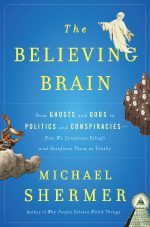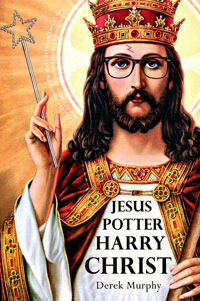In this week’s eSkeptic:
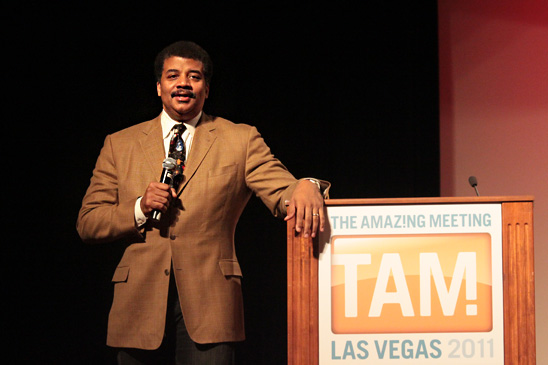
photo by David Patton
SKEPTICALITY: Interview with Neil deGrasse Tyson
This week, devotees of the skeptical community gathered in Las Vegas to participate in the James Randi Educational Foundation’s 9th annual Amaz!ng Meeting. In this week’s Skepticality, just off the plane from the conference, Derek & Swoopy share their interview with TAM 9 keynote speaker, author & astrophysicist Neil deGrasse Tyson.

NEW ON MICHAELSHERMER.COM
A. C. Grayling reviews Shermer’s latest book:
The Believing Brain
In Nature (one of the most prestigious science journals in the world), world-class scholar A. C. Grayling says, “This stimulating book summarizes what is likely to prove the right view of how our brains secrete religious and superstitious belief.” Grayling is the author of The Good Book and Life, Sex and Ideas: The Good Life Without God.
NEW ON SKEPTICBLOG.ORG
Gambling on ET
In this week’s Skepticblog, Michael Shermer asks, “Is there some metric we can use to calculate the odds that claims of extraterrestrial life discovery are real and reliable? There is…

NEW ON SKEPTICBLOG.ORG
Thoughts on The Amaz!ng Meeting 9
Daniel Loxton returns from the Amaz!ng Meeting 9 conference, and shares his thoughts about some of the convention’s emergent themes. In particular, several speeches explicitly tackled the practical aspects of effective, empathic communication—and especially, the ways in which effective activism depends on well-considered messaging.
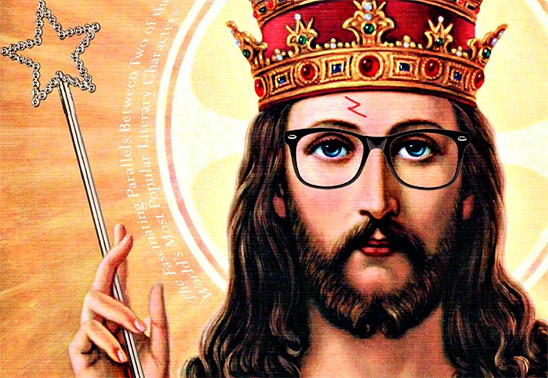
About this week’s feature article
In this week’s eSkeptic, Tim Callahan reviews Derek Murphy’s book Jesus Potter Harry Christ (Portland, OR: Holy Blasphemy Press). Tim Callahan is Skeptic magazine’s religion editor and author of the books Bible Prophecy and The Secret Origins of the Bible.
SUBSCRIBE to Skeptic magazine for more great articles like this one.
Harry Potter and Jesus Christ
a book review by Tim Callahan
At first glance, the title of this work, along with the cover illustration depicting a man who seems the amalgam of Jesus Christ and Harry Potter, seem whimsical. Yet, Derek Murphy is serious in his comparison of Harry Potter with Jesus by noting the many parallels between the two:
- Magic father, human mother
- Miraculous birth foretold by prophecy
- Threatened infancy: Herod tries to kill Jesus. Voldemort kills Harry’s parents in an attempt to kill him.
- Raised in obscurity
- Both possess magical powers and do battle with evil
- In both stories, the hero is symbolized by the lion, while his enemy is symbolized by the serpent.
- Both stories stress the power of faith and love.
- Both heroes experience a sacrificial death and resurrection.
Of course, the main difference between two is that Harry Potter is known to be fictional, while Jesus is presumed to be historical. However, works of comparative mythology, among them Sir James Frazier’s multivolume work The Golden Bough, reveal consistent parallels between pagan gods and Christ. So striking are these parallels as to provoke the response from the great 20th-century Christian apologist C.S. Lewis that these earlier myths were pale reflections of the true myth, that of the Christ. Lewis reasoned that God used these earlier myths to introduce human beings to the concepts of death and resurrection that were historical in Jesus Christ. As Murphy notes, Lewis was not the first to attempt to explain away mythic parallels between Jesus and earlier god-men. In the second century St. Justin Martyr (103–165) wrote in his First Apology, chapter 21:
And when we say also that the Word, who is the first-birth of God, was produced without sexual union, and that He, Jesus Christ, our Teacher, was crucified and died, and rose again, and ascended into heaven, we propound nothing different from what you believe regarding those whom you esteem sons of Jupiter. For you know how many sons your esteemed writers ascribed to Jupiter: Mercury, the interpreting word and teacher of all; Asclepius, who, though he was a great physician, was struck by a thunderbolt, and so ascended to heaven; and Bacchus too, after he had been torn limb from limb; and Hercules, when he had committed himself to the flames to escape his toils; and the sons of Leda, and Dioscuri; and Perseus, son of Danae; and Bellerophon, who, though sprung from mortals, rose to heaven on the horse Pegasus. For what shall I say of Ariadne, and those who, like her, have been declared to be set among the stars? And what of the emperors who die among yourselves, whom you deem worthy of deification, and in whose behalf you produce some one who swears he has seen the burning Caesar rise to heaven from the funeral pyre?
Where C. S. Lewis explained the similarities as imperfect reflections of the true myth, Justin Martyr explained them as “diabolical mimicry,” i.e. that demons, knowing what God was planning to do in the future planted these myths so as to make it seem that the story of Jesus was the copy instead of the original.
Murphy examines many of the specific forerunners of the Christ myth, starting with Dionysus. Jesus turning water into wine, at the wedding feast at Cana (John 2:1–10) duplicates a miracle originally performed by Dionysus, who, along with Jesus was called the “true vine” (see John 15). Both were born of mortal women, killed and resurrected. Dionysus was called the “twice born” and initiates into his cult were said to be born again (p. 118). He was twice born because Zeus initially sired him on the goddess Persephone. The titans killed him and ate most of his body, but Zeus saved his heart and used it to impregnate Semele. When Semele is struck by lightning Zeus rescued the unborn child from her womb and sewed it into his thigh, from which the infant Dionysus was born. There are also parallels between the release of Peter on one occasion, and Paul and Silas on another in the Book of Acts (Acts 12:5–10 and 16:25–27), and the release of the followers of Dionysus imprisoned by Pentheus in The Bacchae. In both Acts and The Bacchae the fetters fall from the limbs of the prisoners, and the doors of the prison open of themselves.
The Egyptian god Osiris was another dying and resurrecting god, whose worship along with that of his wife Isis had spread through the Roman Empire predated Christ. In a debate I had with Christian apologist Gary Habermas, he pointed out that Osiris was only resurrected in the underworld. Thus, his was not a true resurrection. That stopped me somewhat, and it wasn’t until well after our debate that it occurred to me that Osiris, having been chopped into 14 pieces by his enemy, Set, is first put back together, then physically reanimated. In any case, the original Egyptian story was certainly altered by Roman times to give the worshiper of Osiris the promise of physical resurrection in the afterlife. The cults of Isis and Osiris also leant their imagery to Christianity, which co-opted the image of Isis and the infant Horus (begotten supernaturally) as the image of the Madonna and Christ child. Likewise, the Pieta, portraying Mary mourning the dead Jesus, owes its imagery to that of Isis mourning the dead Osiris.
So far, I am in agreement with Murphy. However, I find myself less in concurrence with his argument for astrologically based origins of Christianity. Consider, for example, this quote (p. 198):
Many traditions have called the three stars of Orion’s belt the “kings” or the “magi.” They form a direct line to Sirius and appear to follow him to the birthplace of the sun. Try to find them early on Christmas morning—they’re the brightest stars you see.
While the image of three magi presenting gifts to the Christ child appears on an incised sarcophagus slab from the third century, the Gospel of Matthew—the only account in which the magi appear—says nothing about their number. Rather it says (Mt. 2:1, 2):
Now when Jesus was born I Bethlehem of Judaea in the days of Herod the king, behold, there came wise men [Gr. magoi] from the east to Jerusalem, saying, “Where is he that is born King of the Jews? For we have seen his star in the east and are come to worship him.
The number three seems to have been inferred from there being three gifts given by the magi: gold frankincense, and myrrh. The magi coming from the east makes them Zoroastrian holy men from the Parthian Empire, Rome’s archenemy. Thus, the magi recognizing Jesus as the true king of the Jews stands in stark contrast to Herod, a Roman appointee. Thus, in the political, messianic mythology of Matthew’s Nativity, the motif of magi from the east doing homage to the Christ child was an affirmation of his status as king and messiah. My one great criticism of this book is that it fails to consider, along with pagan origins of the Christ myth, its reliance on the Jewish scriptures, as well as on Jewish messianism of the first century and the political mythology that surrounded it.
The birthday of Jesus on December 25, like the identification of the magi as being three in number, is a post-biblical addition to Christianity. However, it may be of genuinely astrological origin as a solar myth, since the sun was seen to be reborn on the solstice. Due to the failure of the Julian and earlier Roman calendars to adequately deal with the partial day at the end of the solar year—roughly, but not quite, a quarter of a day, the winter solstice, originally in early January had, by early Christian times, slipped to December 25. Making it the birthday of Jesus might have been a bit of syncretism designed to blot out worship of the sun as Sol Invictus (Latin for “unconquered sun”). Eventually, with the establishment of the Gregorian calendar, the solstice was fixed at December 21. As Murphy points out, early images of Jesus showed him as a beardless sun god.
Murphy’s assertion on page 205 of a pagan inspiration for Nativity stories certainly holds true for Luke, though I’m not sure how much of this to equate with astrological symbolism. I do agree with Murphy’s identification of the Christian cross as a solar symbol. Assuming Jesus to be historical and his crucifixion to be an actual event, the device upon which he was put to death would have been shaped like a capitol “T”.
In Part Three of the book, titled “The Accidental History,” Murphy asserts that Christianity as intended by Paul would have been a mystery religion, but that it was co-opted by others with a different agenda. Certainly Paul himself had an agenda, one that transformed an original Jewish sect into a new religion. Thus, if there was a historical Jesus, Paul quite simply dispensed with him. Paul makes this plain in his very telling epistle to the Galatians, toward the beginning of which he states (Gal. 1:11, 12):
For I would have you know, brethren, that the gospel which was preached by me is not man’s gospel. For I did not receive it from a man, nor was I taught it, but it came through a revelation of Jesus Christ.
Having been given a direct revelation from the risen Christ Paul says (Gal. 1:16b, 17a), “I did not confer with flesh and blood, nor did I go up to Jerusalem to those who were apostles before me.” When he finally did go to Jerusalem after three years he stayed briefly with Cephas (Peter) and also spoke to James, but none of the other disciples (Gal 1:18, 19). Did Paul receive anything of value from those who knew Jesus? No, he did not (Gal. 2:6): “And from those who were reputed to be something (what they were makes no difference to me; God shows no partiality)—those, I say, who were of repute added nothing to me.”
Thus, in Paul’s own words, he tells us that, even if there had been a historical Jesus, the Christ Jesus of his epistles was created out of his own imagination via some sort of mystical conversion experience; and the Jesus of the gospels was a construct of messianic expectations, reworked Jewish scriptures and pagan myths. That Paul reports his contacts with people who knew Jesus, indicates to me that there was a Jesus to be known but that he wasn’t anyone Paul ever met or wanted to meet.
It is Murphy’s assertion that what Paul tried to create was another mystery religion on the order of those of Dionysus, Mithras and Osiris/Isis. To judge whether or not this was indeed Paul’s aim, we need to understand just what a mystery religion was. The author lists the characteristics of mystery religions as follows:
Code of silence, Hieros Logos (sacred history), Hierarchy of initiation, Brotherhood, Ritual death and rebirth, Identification with God, Code of Ethics, Spiritual afterlife
The code of silence—keeping the doctrines of the religion secret—is what makes these faiths specifically mystery religions. The heiros logos, or sacred history, record the miraculous deeds of the deity at the center of the cult—often a semi-mortal being whose birth is miraculous, whose life is exemplary, who teaches a code of higher ethics, undergoes an excruciating death, yet overcomes it, with the promise that his followers can do likewise, if only in symbolic terms. The hierarchy of initiation leads the initiate through ever higher levels of enlightenment as he or she progresses in gnosis. In the process of initiation members of the mystery religion experience brotherhood with fellow initiates. Eventually they experience a ritual death and rebirth, dying to their old, carnal selves and being reborn as spiritual beings. As such, they experience identification with God. As such, they practice a code of high ethics and live in expectation of a spiritual afterlife, free of the bonds of carnal corruption. Members of mystery religions enjoyed a sense of communion with their semi-mortal saviors that involved a personal relationship with God (p. 293). So also did the Titans eat the flesh of Dionysus, and so, too, did Paul recount Jesus initiating the symbolic drinking of his blood and eating of his flesh (1 Corinthians 11:23–26). Notably, Paul records that this is the only detail of the life of Christ, other than the Crucifixion and Resurrection.
Even accepting that Jesus was as fictional a character as Harry Potter, we may ask how Harry can compare to Jesus. Murphy notes (pp. 417, 418):
Most importantly Harry Potter is popular in a way Jesus is not. Harry Potter’s movies have made billions, while Mel Gibson’s Passion of the Christ (2004) was disturbing, bloody, and ultimately unsatisfying, riddled with unresolved complexities in a system where the all powerful and all knowing God has to trick or deceive his creation, Satan. Harry’s popularity is crucial—he is the gospel of our time; the best selling story. Yes, he is a repacking of the Jesus Christ story, but one that eclipses that story completely. While we can sift through Harry and trace back to Jesus, why would we? Harry is a much more humane, in depth, vibrant character than the Jesus of the gospels, infinitely easier to identify with, champion and even love.
Whether or not one agrees with Murphy’s ultimate position, and whether or not one agrees with his arguments that Jesus was entirely (rather than mostly) mythic, Jesus Potter Harry Christ is well worth wading through, and wade through it one must, simply because of the sheer mass and volume of evidence the author provides. Make this a book whose pages you dog-ear for further reference and second readings.
Skeptical perspectives on the Bible…
-
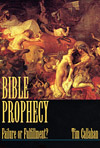 Bible Prophecy: Failure or Fulfillment?
Bible Prophecy: Failure or Fulfillment?
by Tim Callahan
-
 The Bible Against Itself
The Bible Against Itself
by Randel Helms
-
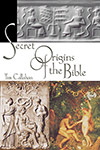 Secret Origins of the Bible
Secret Origins of the Bible
by Tim Callahan


